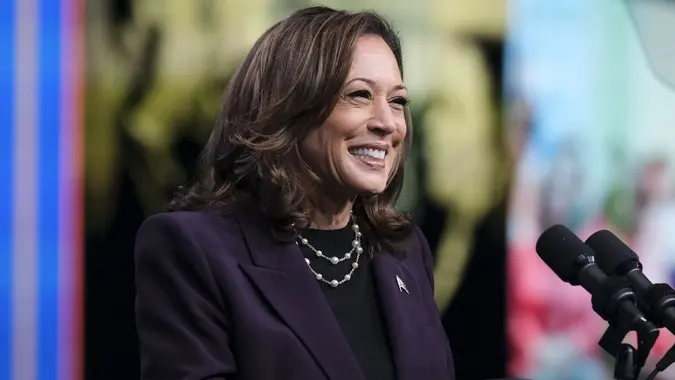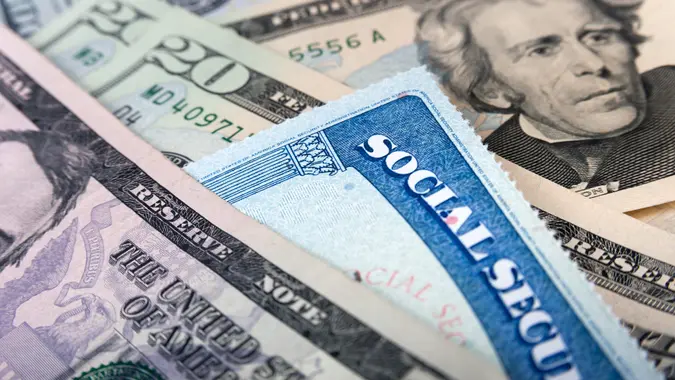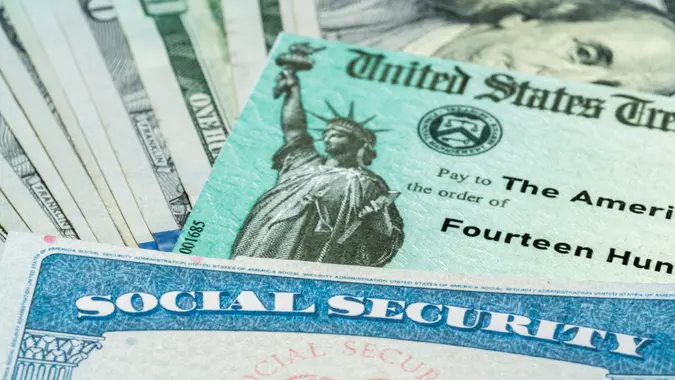I’m a Retirement Planner: What Social Security Could Look Like in a Decade if Harris Is Elected

Commitment to Our Readers
GOBankingRates' editorial team is committed to bringing you unbiased reviews and information. We use data-driven methodologies to evaluate financial products and services - our reviews and ratings are not influenced by advertisers. You can read more about our editorial guidelines and our products and services review methodology.

20 Years
Helping You Live Richer

Reviewed
by Experts

Trusted by
Millions of Readers
It’s no secret that Social Security is in trouble. In fact, according to the recent Social Security and Medicare Trustees report, Social Security’s OASDI trust fund asset reserves will be depleted by 2035. And while both political parties have vowed to save the program, their approaches would likely be very different, as would the look of Social Security in a decade.
With that in mind, we asked retirement experts what Social Security would look like in 10 years and beyond if Kamala Harris wins in November.
Increased Maximum Wage Base
Currently, workers pay Social Security taxes on the first $168,000 of earnings. This number increases slightly each year. If you are a W-2 worker, you pay 6.2% of the payroll tax, while your employer pays 6.2%. If you are self-employed, you’re on the hook for the entire 12.4%. But of course, since Social Security is on track to go bankrupt, we know that this is not enough.
“The main point of the Biden plan for Social Security, which Kamala Harris has publicly supported, is to increase the maximum wage base to $400,000,” said Devin Carroll, owner and lead advisor at Carroll Advisory Group, which specializes in retirement planning. But, it’s complicated.
Basically, “[Harris’s] proposal would have the Social Security portion of taxes withheld from your paycheck kick back in once you earn $400,000 or more. That would create a gap between the current maximum taxable wage base ($168,000) and $400,000,” said Carroll. The gap would get smaller as the lower amount would increase each year. So, in 10 years, that gap would be much smaller and more wages would be taxed. “Some reports say that within 30 years, all wages would be subject to Social Security taxes under this change,” said Carroll.
Unfortunately, said Carroll, this would not be a permanent fix. “The actuaries at the Social Security Administration have already looked at multiple versions of this approach, and the best-case scenario is that it extends the date where the Social Security trust fund is dry from 2034 to 2044,” he said. “So it just lightly kicks the can down the road.”
Increased Taxes and Increased Benefits
Here is where a Harris administration might differ greatly from a Trump administration. Whereas the Trump administration might tack toward privatization of Social Security, resulting in more control by individuals at the expense of more risk to themselves and the program, a Harris administration likely would strive to shore up the traditional model, said Peter McClosky** a CEO of a health consultation and planning organization.
In a nutshell, it could mean tax increases on the wealthy, he said. “In the case of younger people, this might mean that a future benefit will be more predictable and reliable, enabling a more traditional approach toward retirement planning,” he said. “Those nearing retirement may have increased benefits or more robust support that might alleviate some of the financial pressures.”
So, What Should You Do?
That all depends on your age, and who wins in November. But, each expert agreed that the safe bet is to take control of your retirement planning as early as possible, which includes not planning to depend on a robust Social Security benefit, whether it’s 10 or 40 years in the future.
Particularly if you are young, start saving now and take advantage of employer-sponsored retirement plans, said McClosky. “Those who are approaching the end of their working life will want to make sure they have protected income flows with minimum risk as they near retirement age.” And those in mid-career should vigilantly assess their retirement strategies and stay nimble enough to adapt to changing political and economic times.
**Names in this article have been changed for privacy.
Editor’s note on election coverage: GOBankingRates is nonpartisan and strives to cover all aspects of the economy objectively and present balanced reports on politically focused finance stories. You can find more coverage of this topic on GOBankingRates.com.
 Written by
Written by  Edited by
Edited by 
























